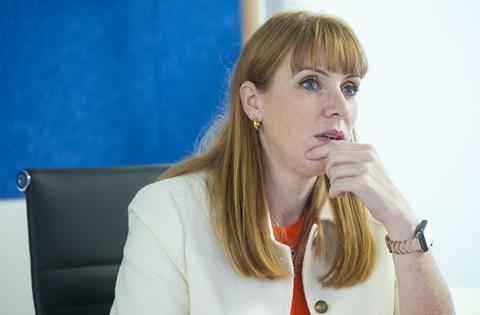Housing secretary “not giving up” on manifesto pledge as project announced with Land Registry to ensure easier data-sharing
The government has announced plans to digitise information and ensure easier data-sharing in a bid to slash the amount of time it takes to buy or sell homes.

The Ministry of Housing, Communities and Local Government (MHCLG) today announced its ambition to create a “fully digitalised home buying and selling process”.
It is the latest policy ministers hope will help speed up housing development towards 1.5m homes by 2029 - a key manifesto pledge that housing secretary and deputy prime minister Angela Rayner today insisted she is still determined to meet despite falling completions.
An MHCLG spokesperson said that currently information such as building control and highways details are predominant paper-based or recorded in non-machine readable formats. The department also said there are not established protocols for accessing, sharing and verifying data, which slows down the process.
MHCLG today announced a 12-week project, backed by the Land Registry, to design and implement data rules for the property sector so information can be more easily shared between conveyancers, lenders and other parties involved in a transaction. The work will be carried out with the Digital Property Market Steering Group, a collection of sector and government experts, set up by the previous government which includes the Royal Institution of Chartered Surveyors and mortgage lenders’ body UK Finance.
MHCLG believes its reforms would mean key information will be available immediately, with identity checks carried out at once.
A spokesperson said making more information “available at people’s fingertips” will mean surprises are less likely later in the process making it “easier for people to get onto the housing ladder”.
Rayner said: “We are living in a digital age, the house buying process isn’t very digital, it’s very paper-led so what we want to try and do is work with the Land Registry to have more digitalised copies, including digital ID and signatories.
“We do this a lot with our banks for various things now and therefore we think that we can streamline that process and make it quicker.”
Rayner, speaking on BBC’s Sunday with Laura Kuenssberg show, also said she knew hitting 1.5m homes by the end of the parliament “was going to be really difficult” and was asked within her first month whether she should review the key manifesto pledge.
“When we came into government and we saw the trend, [it] was going backwards, so not only were you having to reverse the trend but then push ahead.
“We felt that it was made even more challenging, but I wasn’t going to give up on the target.”
Official figures show there were 221,070 net additions to England’s housing stock in 2023/24 (including 198,610 new build), a reduction of 6% on the 234,290 recorded for 2022/23.
Rayner added however that she is “determined to meet the 1.5m homes target” and pointed to several policies announced so far to help achieve it. These including pushing councils to identify land for new homes in their local plan, extending the mortgage guarantee scheme after this year, slashing Right to Buy discounts, and making an extra £500m available in the current Affordable Homes Programme.
>>See also: The 1.5 million-home question: Does the government’s planning reform programme add up?
She said: “There’s no excuses to not build those homes that people desperately need. And we mean business on this, because far too many people are not getting those homes. [There are] 160,000 children in temporary accommodation.
“That costs us billions of pounds, but I’m determined that I will meet the 1.5 million homes target. So, we’re tracking where we’re up to. We don’t expect it to change overnight.”










No comments yet